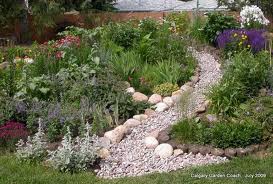Once a large house gets built on a small lot, it’s an all too common situation when the water that once flowed or ran off in one direction is altered. This can mean standing or running water on a landscape. It’s often a result of poor drainage because the natural features which previously permitted good drainage no longer exist. In many of the newer neighborhoods, based on the fact that large houses are being built on small lots, it is mandatory for the developer to install catch basins, buried pipes, and open concrete swales to direct the runoff from the homes.
Many homeowners are taking matters in their own hands as their houses are built on spaces that have extreme landscapes. Due to placing new homes on the side of a hill, on a steep slope, at the bottom of a hill, or even built into the side of an extreme hill working, with water and how it flows on a lot has become more important. Now homeowners are installing dry stream beds that take care of directing periodic water flow as well as offering a visually interesting and beautiful focal points for their landscapes. They are lining dry creek beds with well-worn stones or boulders and softening the edges with plantings that catch the eye.

If you’re dealing with drainage and erosion issues due to occasional flowing water, consult a professional landscape design architect who can help you identify the source of the problem as well as recommend effective and attractive solutions such as dry stream beds.
- About Us
- Services
- Residential Landscaping Services
- Commercial Landscaping Service
- Landscape Design
- Deck Building
- Porch Building
- Outdoor Kitchens
- Custom Decks Porches Pergolas
- Unique Garden Plantings
- Waterscaping
- Hardscapes
- Excavation
- Walkway Design and Construction
- Carpentry Services
- Grading & Drainage
- Custom Boulder & Stone Work
- Living Spaces & Kitchens
- Holiday Lighting
- Outdoor Lighting
- Landscape Maintenance
- Outdoor Fireplaces & Fire Pits
- Custom Outdoor Furniture for Modern Living
- Snow Removal
- Our Work
- Blog
- Contact Us
